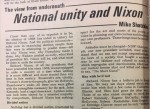While the Democalypse appears to be upon us – and Canada an increasingly compelling candidate for a four-year vacation – it’s not too far-fetched to say this isn’t the first time America has been on the “precipice of doom.”
If for some reason you were stuck in a cryogenic chamber and just awoke from your slumber, know that Donald Trump will be our next president. The road to 270 electoral votes was nail-biting in all possible ways, but the country has chosen Trump as its leader for the next four years.
Thousands of UCLA students have made clear their opinions on Tuesday night’s election outcome – with protests, demonstrations, and blazing pinatas. For some, the election crushed their hopes and dreams, filling them with fear for their futures and their lives. For others, it was a triumph eight years in the making.
While an atmosphere of apprehension hangs over students who fear for what Trump is capable of doing – and destroying – we need to remember this isn’t the first time America faced the prospect of a ruinous presidency.
In fact, in 1968, when Republican Richard Nixon won a landslide victory against Democrat Hubert Humphrey – a shameful defeat in which California, Illinois and Ohio all went towards Nixon’s 301 electoral votes – Democratic supporters expressed skepticism over the president-elect’s ability to unite a country torn apart by the Vietnam War.
On Nov. 13, 1968, the Daily Bruin ran an opinion submission by Mike Shatz criticizing Nixon of being the “least equipped to unite a country at a time when uniting it is more difficult and more critical and than any time in this century.” The submission continued to say Nixon needed to deliver on his promises to the country, and that “good intent and flowery phrases” wouldn’t keep the country’s youth from rejecting the status quo and “resenting its old values.”
Shatz called for less restrictive marijuana laws, more respect for the youth’s voice and for the presidency to address the disunity polarizing the country. After 48 years, it looks like the same issues are still on the table – albeit with greater energy behind them.
Once again, the next president is tasked with uniting the country divided on ideological fault lines, improving the nation’s economic standing and making good on campaign promises – of which there are many. And once again, students are upset with a predominantly older American electorate deciding the election for someone they do not support.
As much as students may disagree, this election seems to resemble a story of same old, same old. Of course, the stakes are heinously greater this time around – with progress and social equality in jeopardy – but there’s a reason elections are every four years. And much like in 1968, with Nixon’s untrustworthiness eventually overwritten by Jimmy Carter’s die-hard honesty, the presidency this time around will continue to reward only those most suitable.
Society stands to lose – or gain, depending on your political preferences – a great deal with Trump’s presidency, but the Oval Office is in a quadrennial flux. Those in opposition just need to muddle through the next four years.
